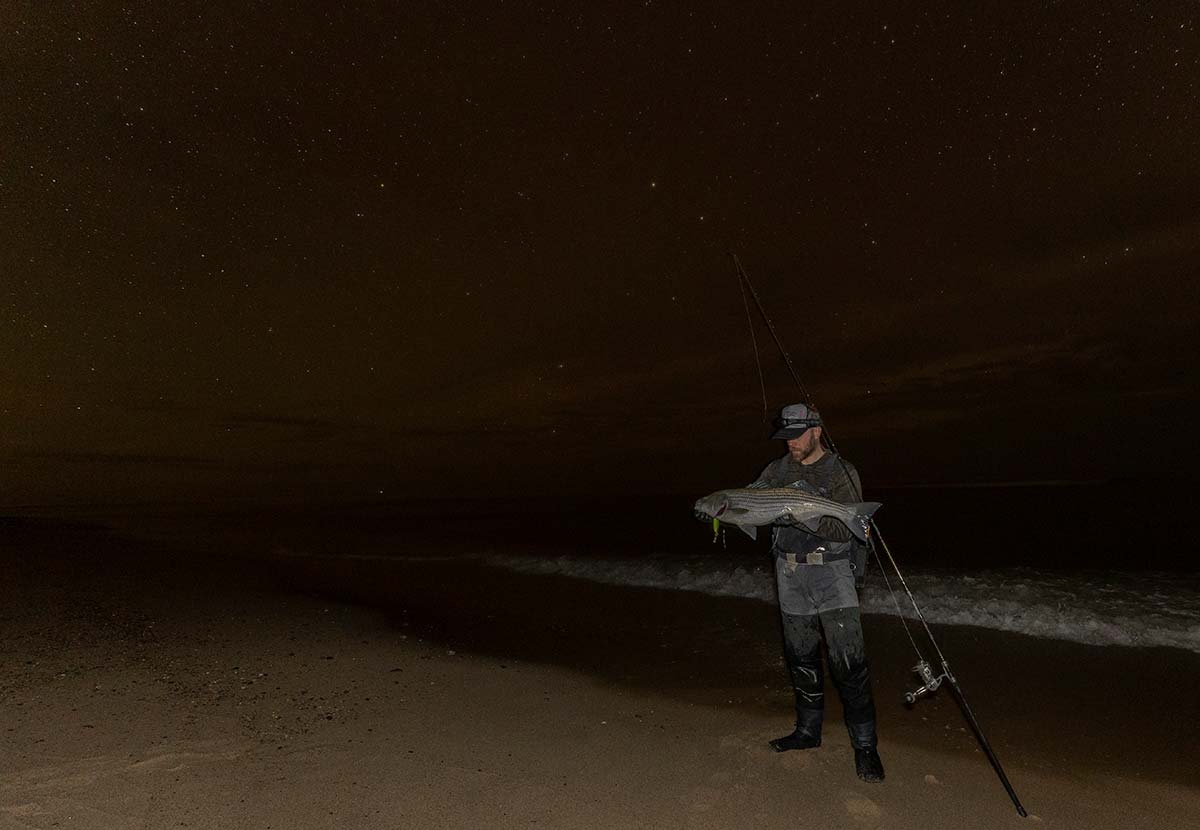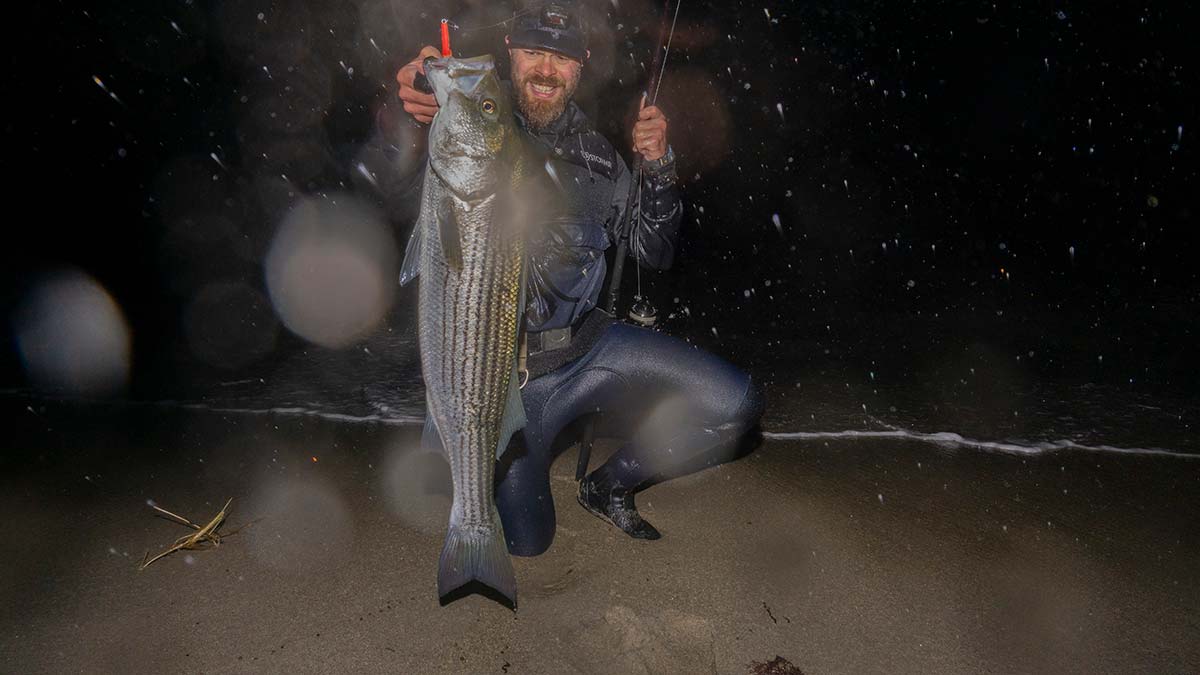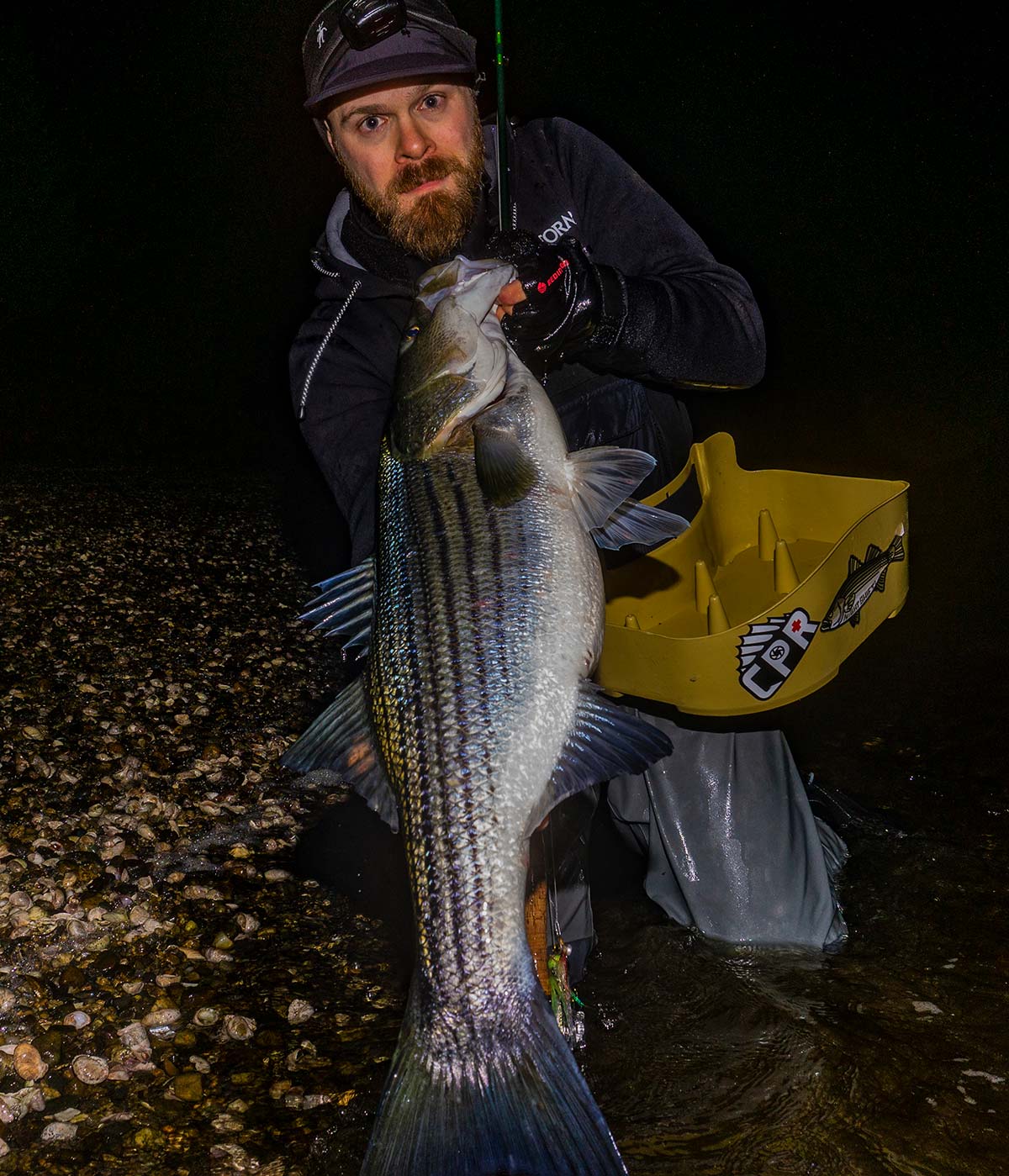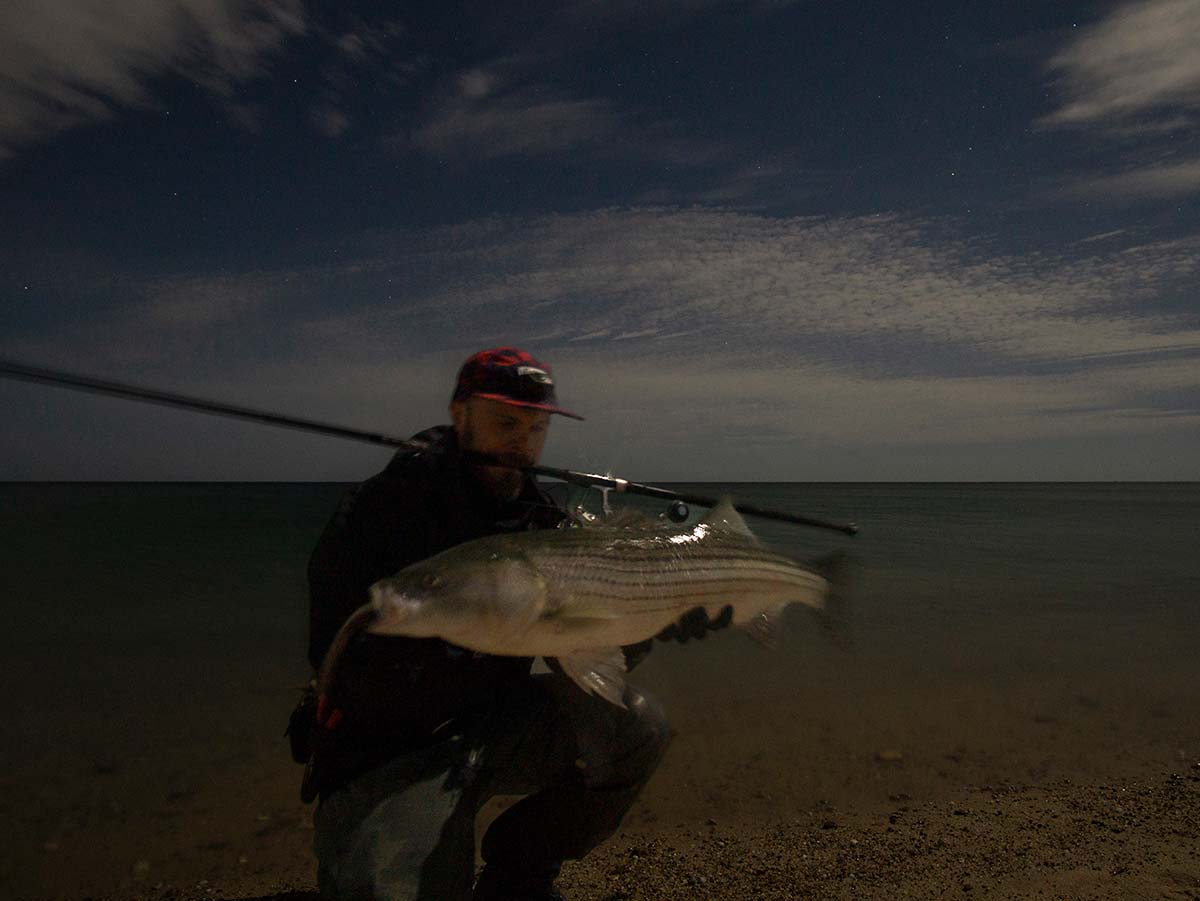
A November pep talk for all the surfcasters out there, don’t hang the rods just yet!
Once the witches and skeletons are taken down, and swapped out for scarecrows, turkeys, and cornucopias, I feel a heavy sense of dread. The turning of the calendar from October to November is depressing for me as a striped bass angler, the worst transition of the entire calendar. The turning from September to October is still filled with hope, I’ve had some of my best fish in October. Even the turning of November to December is less painful; I’m often ready for a break, sick of the freezing cold, and suffered enough skunks to let the season go.
But there’s still lots of potential in November, and no time to waste, no excuse to quit just yet. If Stezko’s world record 73-pounder on November 7th doesn’t prove my point, I’m not sure what ever will. Yes, things have changed a lot for the fall run in the last 25 years (for reasons no one can confidently explain) but there’s always fantastic fishing across southern New England in the 11th month. But it’s going to get difficult, and you’re going to have to focus, take advantage of opportunities as they present themselves, and develop a healthy dose of grit and determination. If nothing else, that should be the takeaway.
Late Season Spots
Outside the popular holdover rivers and estuaries – which is a whole other article – there are still plenty of places you can catch stripers in the actual surf, or “out front” as many of us call it.. Stick to the striper spot essentials; presence of current and structure that traps bait, and then start working on figuring out the best stage of tide and way to present your bait or plug.
That being said, you might be surprised where stripers pop up in November. Frankly, if you have a good spot in October, especially if you’re still getting fish on the backside of the final moon of the month, it very well could be a good spot deep into November, too. Fish stay much later than fishermen tend to hunt them, particularly if you’re on the western end of the island or around the Metro area. Just because things cool off for a bit after that late October moon, as it often does, stay on it through at least the first November moon, you may be pleasantly surprised, I have been!
One very specific tip: I have the best luck in places with lots of bait. That sounds like a “no duh” statement, but unlike many other times of year, the higher the concentration the better. In November, I tend to lean heavily on sand eels, spearing, and shad, because all three seem to be abundant in the places I frequent. I will walk right by little pockets of these, looking for the mother lode; the structure that concentrates these baits to the highest density. This is going to attract the last of your migrating fish, or the low concentration of fish that are going to stay the winter. That’s because with less competition the fish won’t spread out; they will only be where conditions are perfect.
Over and above sand eels and shad, everything from mackerel and bunker to crabs and shrimp are still in play, and it’s an important part of your job to understand what makes your spots tick… and bait is a huge part of that equation. Figure out what’s around in your spots in November, and focus on it. In many cases it’s not all that different than what you were finding in October or even September, there will be shifts and slumps, but often the main course stays the same.

Night Is Still Right
There’s something about late fall that converts many of even the purest vampire surfcasters into day-walkers. There is, I guess, a strong temptation to abandon the hunt for larger fish, and instead “succumb” to the final push of small schoolies that can be easier to find, as they run along the beaches and harass small bait. The temptation for a “final fish,” or “just bending the rod” starts to eclipse any effort or desire for the “hunt.” But this often will not yield you the best fish. Sure, I hear of 35-pound-plus fish every year that are caught from schools of micros, but this is by far the exception, not the rule.
If you don’t like the cold, and are satisfied with your season, then by all means fish in the afternoons. However, if you are still excited about intercepting one more decent fish, then you’re going to want to retain your nocturnal tendencies. In November, I still only fish at night- and I mean truly full dark and into the wee-hours. I am a tidal fisherman- I fish primarily around what the tide is doing. Therefore, if the best tide is at 1 a.m. on November 9th, that’s when I’ll be fishing. I will not succumb to the temptation of fishing suboptimal tides at 5 p.m. or even 9 p.m. And I certainly won’t be fishing at 3 p.m.!
Windows Of Opportunity
Another important piece of advice about fishing the surf in November is taking absolute advantage of favorable conditions. For my spots and patterns, there’s no doubt that warm weather and gentle winds tend to produce better fishing. These nights are not common as we move through November, and they cannot be squandered. In September and October (and from April through the summer) you can get away with letting a night slide by if it’s inconvenient, there will be another. That is not true in November. Typically, I only get five to seven really favorable weather nights during the month that match up with tidal conditions at my favorite late-season spots. Some years, I might only get two! For this reason, you can’t always wait until Saturday night. You have to strike while the iron is hot.
Because opportunities slip right on by, I suggest being aware of what could come into play at least a few days ahead of time, from the last week of October through the middle of November. That is, it’s smart to have a running list in your head of spots that are “in play” during any given stretch of three-to-five days. Know what spots work in terms of tide and wind, so if you get a warm stretch, you’re not caught flat-footed. In November you should be more vigilant.
Remember, since it’s dark at 5 p.m., you don’t have to stay out late and it gets light so late in the morning, you might not have to get up early either. But sacrificing a little sleep, or being tired, is easy this time of year, at least for me, because you know you’ll be getting plenty of rest in a couple of weeks when you finally hang it up. It’s tough to sit inside for three or four hours to hit a 9 o’clock tide, that’s still relatively early. But if you’re constantly ready and aware of what’s happening with your spots, you might be able to get most of your fishing in prior to 9 p.m. in November – it’s all about taking advantage of the moments when they come.

Time Spent
On the heels of this advice, is the same advice I give any surfcaster, all season long: you simply have to spend time fishing. Yes, you can fish smart, focus, and key in on productive windows, that’s what I do. But you also need to put in hours of time, stretch yourself, and take some risks to test out new potential patterns and theories. It’s a self-fulfilling prophecy. If you head out for 45 minutes, get cold, and quit before your 90 minute window ends, or if you go out at 5 p.m. when you know the best fishing won’t start until 8, you’re setting yourself up to fall short. Don’t do that! Instead, push yourself to fish for the “full time” that is typically required of a spot earlier in the fall. You’re going to catch fewer fish this time of year, and have longer stretches of no hits. Just accept that and resist the temptation to compare it to September or October, shift your expectations. It makes putting in the time more palatable.
To make this easier as you’re learning, treat your trips not as fishing trips, but scouting missions. Give yourself the excuse – if you need it – that you’re checking out spots and poking around as an investment in next season. This makes it easier to suffer through low fish counts, takes the pressure off, and gives you an “out” when your buddies give you a hard time about not hanging it up and “wasting” time. Every trip should have a purpose, and while there are many fish to be caught in November, you can double-dip and give yourself more motivation when your hands are freezing and you haven’t had a hit in three hours…or three days.
Making Moves
That being said, in November I’m bouncing all over the place. I will line up several spots that work on that particular night (maybe even a half-dozen or more), and prioritize, making sure not all the tides overlap. Then, I’ll start with spot A, fish it until I’m convinced there’s no fish or the pattern passes, and then move to spot B. While spring and summer I tend to really just focus on one or two spots, and spend two to four hours at each, in the late fall I will jump ship more quickly. I’ll pick my best bet, and if it doesn’t work out, I’m not going to roll the dice and camp out at the spot. I cannot tell you how many times that second or third move has resulted in a night-saving run of fish, even though I had initially determined it to have a lower priority than the first spot. Let me be clear, this doesn’t mean I fish my spots randomly or outside of prime-time, rather it means I only fish them during the peak of prime time, and if they aren’t producing, I’m not hanging around.

Don’t Suffer The Slide
The final reminder I have for you is tackle related. If you lighten up your rod and reel, and then use smaller lures to match, you’re going to preferentially catch smaller fish. Then, as you catch these fish, you’re going to assume that’s all that’s around, begin to focus on them, and decrease your shot at anything larger. Don’t do it! Even if I’m up inside an estuary or fishing some backwater spot, I’m throwing darters, metal lips, big soft plastics, and gliders. I refuse to succumb to the small paddletail, tiny jig, or four-inch plastic swimmer. Frankly, the small fish will almost certainly take those larger lures anyways, but if I stick with the large lures I’m much more likely to intercept something special, too. This also goes for fly fishing, November is a great month for fly-rodding the surf, but you don’t have to use tiny flies and seek out tiny fish. I still use hollows and beast flies like I do in July. And trust me when I say, a single 20-pounder in November is a whole lot more satisfying than banking a dozen 20-inchers every night, I won’t be dreaming of those little rats over the winter, I’ll be lusting over that fish that everyone said was long-gone for the season.




